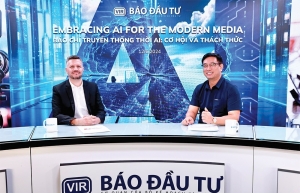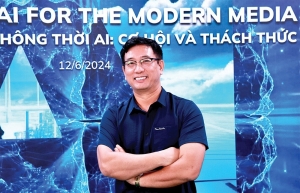Unveiling the media’s dynamics for the AI era
What do you think is the current best way in which to utilise AI in communication, and what should users be wary of?
 |
| Nguyen Thanh Son, chairman of Media Ventures Vietnam Group |
To provide a comprehensive and real-time picture of AI applications in press and media practices, Media Ventures Vietnam has undertaken intensive investment and exploration in the last five years. We have delved into AI opportunities, recognising that waiting for government guidance on digital transformation is not viable. Instead, our group sees AI as a new labour force that must be utilised effectively to stay competitive.
Content creation is a multifaceted process that goes beyond simple production; it encompasses four key phases known as the 4D process. The first phase is the discovery phase, where press and media agencies need to study their audiences and build detailed communication personas.
Understanding target audiences and their communication habits is crucial. AI excels in data analytics, and when press and media agencies provide enough data and a suitable model, AI can rapidly and accurately complete the discovery phase, offering deep insights into audience behaviour and preferences.
Next comes the design phase, where the structure and channels for content are crafted. This phase involves a collaborative effort between generative AI and human creativity. AI can suggest frameworks and optimise channel distribution, but human input is essential to ensure the content is engaging and resonates with the target audience.
The third phase is the production phase, also known as content development. In this phase, AI and humans work in tandem, with AI handling tasks such as content personalisation, automated writing, and creating visuals and music at scale. However, AI cannot replace human creativity entirely. AI models are based on existing content, lacking the unique creativity and innovation that humans bring.
The final phase is the deployment phase, where content is distributed across various channels, and its performance and audience feedback are monitored. AI can significantly enhance this process by providing real-time analytics and adjusting strategies based on audience engagement.
While AI is an exciting development, it also presents certain threats. Users and media leaders should be aware of potential biases in AI algorithms, which can create echo chambers and limit exposure to diverse perspectives. It’s crucial to remain vigilant about the content being consumed and strive to broaden one’s knowledge base.
What are the challenges and the benefits of having rising numbers of AI applications, and how might they change the communication industry in the medium or long-term?
A few weeks ago, I had a meeting with my friend, Ambassador Hoang Anh Tuan, who is Consul General of Vietnam’s Consulate General in San Francisco. He brought representatives of tech companies from the United States to Vietnam, such as Nvidia, and we discussed AI’s potential.
We realised that despite our understanding, we still underestimate AI’s power. The development of AI is akin to the discovery of electricity. Initially, electricity was used merely for lighting, much like today’s generative AI.
However, post-revolution, electricity gave rise to numerous devices such as washing machines and fans, revolutionising daily life in this country. AI’s development will follow a similar path, offering vast opportunities for innovation.
The media industry has witnessed similar transformations, evolving from traditional printing to digital and now computerised methods. These changes underscore the industry’s adaptability and resilience. Predicting the future is challenging, but it is clear that AI will be part of an ongoing revolution, bringing significant disruptions and opportunities.
How do Vietnamese media and communication agencies compete with international ones that can invest more in cutting-edge technology and AI?
Focusing on the opportunities for Vietnamese media, rather than perceiving AI as a threat, is crucial. One significant advantage is overcoming language barriers.
AI’s excellent translation capabilities allow reaching any nation, enabling content to be directed to diverse markets such as the US, France, and Spain. This capability allows the Vietnamese media to compete on an international scale, not just domestically.
Secondly, AI enables precise audience segmentation. Content can be tailored to specific demographics, for example, VIR can easily direct the contents to Korean, Taiwanese, or French investors in their native languages, with personalised messages. This targeted approach can open new revenue streams and enhance a competitive edge.
How can jobs be protected while using AI to handle tasks traditionally performed by humans?
With today’s data-driven news environment, we need to revisit the definitions of media and journalism. Generative AI has already replaced many roles in the industry, such as data journalism, which AI can handle efficiently.
However, authenticity remains paramount. Readers value the genuineness of articles. Additionally, AI-generated content tends to be balanced, but people often seek strong personal viewpoints. This contrast highlights the importance of reporters and journalists in providing deep insights and personal perspectives.
While AI offers numerous benefits, it also presents challenges that must be navigated carefully. By leveraging AI’s strengths and addressing its limitations, the media industry can harness its potential while preserving the human elements that make journalism impactful and authentic. The future will likely see AI and human creativity working together, driving innovation and maintaining the integrity of the media landscape.
 | New AI offerings pose more questions The AI explosion is continuing at pace with new offerings from the biggest tech groups in the world, but ethical concerns and investing considerations are taking up more focus as industries like the media and manufacturing adjust their priorities. |
 | Digital transformation and applying AI in journalism In 2023, the government established a national strategy for the digital transformation of media, with the ambitious goal that by 2030, most media agencies in Vietnam must switch to digital. According to this strategy, all Vietnamese media agencies must reconstruct their newsrooms toward digital convergence. |
 | Redefining the journalism landscape in the age of AI With the recent rise of AI, some journalists and media agencies are fearing an invasion where their journalistic work is used (sometimes without permission) as sources to generate personalised content, or to support social media users in their own quest to become opinion leaders. |
What the stars mean:
★ Poor ★ ★ Promising ★★★ Good ★★★★ Very good ★★★★★ Exceptional
Related Contents
Latest News
More News
- UOB lifts Vietnam growth outlook to 7.5 per cent for 2026 (January 10, 2026 | 09:00)
- Exports cement role as central pillar (January 09, 2026 | 12:37)
- Siemens and NVIDIA expand partnership to build industrial AI operating system (January 09, 2026 | 10:04)
- High targets, hard choices: companies weigh risks in 2026 (January 08, 2026 | 16:58)
- Murphy Oil Corporation achieves appraisal success at Hai Su Vang oil field (January 08, 2026 | 11:35)
- Nestlé Vietnam rolls out its 2026 Lunar New Year campaign (January 08, 2026 | 10:55)
- Acecook Vietnam: 30 years of creating happiness (January 08, 2026 | 08:00)
- Sustainability a core value for DKSH’s vision (January 07, 2026 | 16:00)
- People encouraged to contribute and grow at AstraZeneca Vietnam (January 07, 2026 | 15:48)
- Dat Bike accelerates sustainable mobility (January 07, 2026 | 15:24)

 Tag:
Tag:


















 Mobile Version
Mobile Version